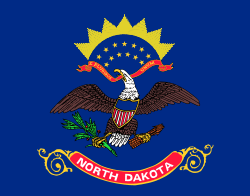William Lemke
| William Frederick Lemke | |
|---|---|
 | |
| 11th Attorney General of North Dakota | |
|
In office 1921–1922 | |
| Governor | Howard R. Wood |
| Preceded by | William Langer |
| Succeeded by | Sveinbjorn Johnson |
| Member of the U.S. House of Representatives from North Dakota's at-large district | |
|
In office March 4, 1933 – January 3, 1941 | |
| Preceded by | Olger B. Burtness |
| Succeeded by | Charles R. Robertson |
| Member of the U.S. House of Representatives from North Dakota's at-large district | |
|
In office January 3, 1943 – May 30, 1950 | |
| Preceded by | Charles R. Robertson |
| Succeeded by | Fred G. Aandahl |
| Personal details | |
| Born |
August 13, 1878 Albany, Minnesota |
| Died |
May 30, 1950 (aged 71) Fargo, North Dakota |
| Resting place |
Riverside Cemetery 46°50′46.2″N 96°47′10.6″W / 46.846167°N 96.786278°W |
| Political party |
Nonpartisan League Republican |
| Spouse(s) | Isabelle McIntyre |
| Children | William F. Lemke, Jr., Robert Lemke, Mary Lemke Ely |
| Alma mater |
|
| Occupation |
|
William Frederick Lemke (August 13, 1878 – May 30, 1950) was a United States politician.[1]
Life and career
He was born in Albany, Minnesota, and raised in Towner County, North Dakota, the son of Fred Lemke and Julia Anna Kleir, pioneer farmers who had accumulated some 2,700 acres (11 km2) of land. As a boy, Lemke worked long hours on the family farm, attending a common school for only three months in the summers. However, the family did reserve enough money to send him to the University of North Dakota, where he was a superior student. Graduating in 1902, he stayed at the state university for the first year of law school but moved to Georgetown University, then to Yale Law School, where he finished work on his law degree and won the praise of the dean. He returned to his home state in 1905 to set up practice at Fargo.
Lemke was the attorney general of North Dakota from 1921 to 1922. He later was elected to the United States House of Representatives in 1932, an NPLer. He served four two-year terms in Congress.
While in Congress, Lemke earned a reputation as a progressive populist and supporter of the New Deal, championing the causes of family farmers and co-sponsoring legislation to protect farmers against foreclosures during the Great Depression.
In 1934, Lemke co-sponsored the Frazier–Lemke Farm Bankruptcy Act, restricting the ability of banks to repossess farms. President Franklin D. Roosevelt signed the act into law on June 28, 1934. The Act was later ruled unconstitutional by the Supreme Court in Louisville Joint Stock Land Bank v. Radford. Lemke tried to get the Act re-passed by Congress, but was stymied by the Roosevelt administration which privately told Congressmen that they would exercise a Presidential veto against the bill. The Act was eventually re-passed and later held constitutional by the Supreme Court. Lemke was a political friend and ally of Louisiana populist Huey Long prior to his assassination in 1935.
Later in 1936, Lemke accepted the nomination of the Union Party, a short-lived third party, as their candidate for President of the United States.[2] He received 892,378 votes, or just under 2% nationwide, and no electoral votes in the 1936 election. Simultaneously, he was reelected to the House of Representatives as a Republican. Many believe Lemke's acceptance of the Union Party nomination in 1936 was out of bitterness toward Roosevelt over the farm mortgage issue. Through the Union Party, Lemke befriended other populists such as Fr. Charles Coughlin.
In 1940, after having already received the Republican nomination for a fifth House term, he withdrew from that race to launch an unsuccessful run as an independent for the U.S. Senate. He ran again for Congress in 1942 as a Republican and served four more terms, until his death in 1950.
Lemke died of a heart attack in Fargo, North Dakota and is buried in Riverside Cemetery.[1][3] Former Atlanta Braves baseball player Mark Lemke is Lemke's second cousin twice removed.
Bibliography
- Edward C. Blackorby. "William Lemke: Agrarian Radical and Union Party Presidential Candidate," The Mississippi Valley Historical Review, Vol. 49, No. 1. (Jun., 1962), pp. 67–84. in JSTOR
- William Lemke Papers at The University of North Dakota University of North Dakota.
- "Lemke, William" in American National Biography. American Council of Learned Societies, 2000.
References
- 1 2 United Press (May 31, 1950). "William Lemke, 71, Congressman, Dies. North Dakota Republican Was Candidate for President on Union Party Slate in '36". New York Times. Retrieved 2015-01-14.
Representative William Lemke, Republican of North Dakota, died on the way to a hospital tonight soon after he collapsed in the Power Hotel in downtown Fargo. He was 71 years old.
- ↑ Lubell, Samuel (1956). The Future of American Politics (2nd ed.). Anchor Press. pp. 151–152.
- ↑ "Lemke, House Veteran, Dies of Heart Attack" (PDF). Binghamton Press. May 31, 1950.
External links
- Dakota Datebook -- August 13, 2004 from North Dakota Public Radio (via PrairiePublic.org) -- article on Lemke
| Legal offices | ||
|---|---|---|
| Preceded by William Langer |
Attorney General of North Dakota 1921–1922 |
Succeeded by Sveinbjorn Johnson |
| United States House of Representatives | ||
| Preceded by Olger B. Burtness |
Member of the U.S. House of Representatives from North Dakota's at-large congressional district 1933–1941 |
Succeeded by Charles R. Robertson |
| Preceded by Charles R. Robertson |
Member of the U.S. House of Representatives from North Dakota's at-large congressional district 1943–1950 |
Succeeded by Fred G. Aandahl |

